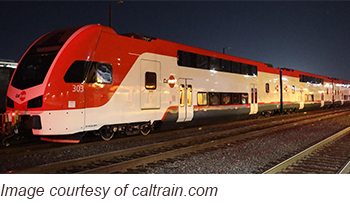The following items are excerpted or summarized from news releases issued by the California Transit Association members. If you are a member of the Association and would like to submit an item to be considered for inclusion in the Member News Library, please email your press releases to Managing Editor Jacob Herson (jake@caltransit.org). Photos and cutline information with your news release submissions, when possible, are encouraged.
Caltrain Receives Funding to Finish Electrification
Caltrain announced at the end of January 2023 that it will receive $367M to finish its Electrification Project, scheduled to be completed in Fall 2024. The funding award, which comes from California’s Transit and Intercity Rail Capital Program’s (TIRCP) Cycle 6 Existing Project Reserve, represents the remaining funding needed to complete the project and begin running passenger electrified rail service. Additionally, this new state funding will allow Caltrain to maintain operations funding identified as a possible means to finish the project. This strengthens Caltrain’s financial outlook and delays a potential fiscal cliff, which had been projected for July 2023.
“We are thrilled that Caltrain has been awarded $367M for the Caltrain Electrification project,” said Caltrain Executive Director Michelle Bouchard. “We want to thank the Caltrain Legislative Delegation, Governor Newsom, CalSTA Secretary Omishakin, Undersecretary Tollefson, Chief Deputy Secretary Edison, and all our state, federal and local partners for their continued support. The Electrification of Caltrain will be a transformational experience for our riders, with more frequent service and enhanced amenities. Not only will it significantly decrease greenhouse gas emissions, it is a major advancement for transit in the Bay Area connecting communities to a transportation network they deserve. We appreciate that the State recognizes the importance of this project and we are excited to now have the funding to complete Electrification in 2024.”
Caltrain also recently received $43M in federal funding for the Electrification Project as part of the omnibus spending bill, which passed Congress and was signed by President Biden in December 2022. The combination of these Federal and State funds means Caltrain has filled the $410M funding gap that was identified in late 2021.
“I congratulate Caltrain on receiving this award as part of the Newsom Administration’s historic investments in transit and intercity rail projects,” said California Transportation Secretary Toks Omishakin. “This funding will help get this transformative project over the finish line and into operation so Bay Area residents can enjoy more of the mobility, safety, environmental and equity benefits that come with riding transit.”
TIRCP was created by Senate Bill 862 to provide grants from the Greenhouse Gas Reduction Fund to fund transformative improvements that modernize California’s intercity, commuter, and urban rail systems, and bus and ferry transit systems, to significantly reduce emissions of greenhouse gases, vehicle miles traveled, and congestion. The most recent round of funding was provided as part of last year’s State budget.
Caltrain is at an important inflection point in its nearly 160 years of serving passengers along the corridor. Caltrain Electrification is the first undertaking in North America in a generation in which diesel trains and their infrastructure components are transitioned to an electrified system. The project will improve the customer experience by increasing the number of trains, modernizing service and adding new safety elements. The new trains will feature on-board displays with digital trip information, increased storage capacities, baby-changing tables, WiFi and power outlets at every seat. Electrification will also help meet ambitious regional and state climate action goals by lowering greenhouse gas emissions, improving air quality and relieving traffic congestion. Additionally, electrified service will advance equity along the corridor by reducing noise and air pollution while increasing access for priority equity communities. It will also set the framework for California’s future High Speed Rail network that will run on the Caltrain corridor.
SunLine Receives Funding for Public Hydrogen Fueling Station
SunLine Transit Agency has been awarded $2,500,000 in Community Project Funding through the 2023 Consolidated Appropriations Act for its Fueling Infrastructure Expansion Project. The funding, secured by Congressman Raul Ruiz, will enable SunLine to upgrade its public hydrogen fueling station to include 700-bar fueling capacity for light and heavy-duty vehicles. These efforts will provide the community with an integral fueling resource and will be key to the region’s transition to zero-emission vehicles. (Source: Townsend Public Affairs Facebook Post)
Santa Cruz Metro Receives Federal Grant and Launches Youth Ride Free Pilot Program
Santa Cruz Metropolitan Transit District (METRO) has been awarded $30 million in new funding by the U.S. Department of Transportation from the 2022 Multimodal Projects Discretionary Grant to fund plans for a new bus-on-shoulder lane on Highway 1 from Freedom Blvd. to State Park Dr., as well as to purchase four zero-emission buses.
“Too many of us know the frustration of being stuck in traffic on Highway 1 between Watsonville and Santa Cruz, which leads to a decrease in our productivity and an increase in our carbon output,” said U.S. Representative Jimmy Panetta. “The Multimodal Corridor Program will bring much needed relief to our congestion problems with an extra lane for public transportation, improvements for the safety of pedestrians and cyclists, and, ultimately, the reduction of our carbon emissions with new zero-emission buses. I’m proud to have partnered with Santa Cruz METRO and Santa Cruz County Regional Transportation Commission to secure this significant federal investment that will help alleviate traffic, improve our livelihoods, and allow us to play our part in dealing with the effects of climate change.”
METRO, Caltrans, and the Santa Cruz County Regional Transportation Commission are working in partnership on the Watsonville-Santa Cruz Multimodal Corridor Program. The funds will go toward improving Highway 1 with a bus on shoulder facility, auxiliary lanes, and bicycle and pedestrian overcrossings between Freedom Boulevard and State Park Drive, including a 1.25-mile segment of the Coastal Rail Trail. Permitted under state legislation, the innovative bus-on-shoulder facility will provide transit vehicles an opportunity to bypass congestion and improve the on-time performance and reliability of regional bus routes. Construction is expected to be completed in 2028.
“We’re thrilled with this major grant win,” said Santa Cruz METRO Board Chair Larry Pageler. “The grant represents a very significant investment that will increase access to transit, improve the speed and reliability of METRO buses, and support our goals to reduce emissions.”
Advancing transportation equity and protecting the environment, the purchase of four zero-emission buses for METRO's regional routes will help connect the community of Watsonville with jobs in the City of Santa Cruz while growing the METRO fleet of zero emission vehicles.
“This project closely aligns with our goals of climate action and resiliency,” added Santa Cruz METRO CEO Michael Tree. “We’re taking a critical step toward our long-term vision to decrease congestion, increase efficiency, and reduce vehicle miles traveled, while supporting a safer and more sustainable community.”
In the same month, METRO announced that its Board of Directors has approved the agency’s first-ever Youth Ride Free pilot program, which will launch March 1, 2023, and will be available throughout Santa Cruz County.
The Youth Ride Free pilot program eliminates fares in order to increase access and encourage ridership for youth in grades K-12. The program will enable youth to ride on all METRO routes (excluding Highway 17) anywhere, anytime. According to a survey conducted by METRO in 2019, just 9.7 percent of METRO riders are under the age of 18, despite making up 19 percent of the population of Santa Cruz County.
“Our local youth represent the future of transit and they need better access to METRO,” said Santa Cruz METRO Board Chair Larry Pageler. “This pilot program is a big step toward reducing barriers in ridership. A key goal for the Youth Ride Free program is to help develop lifelong transit riders, while meeting METRO’s overall goal of increasing transit ridership.”
How the Youth Ride Free pilot program will work for youth:
- Riders in 8th Grade and under may be asked by the driver to identify their grade level or the school they attend. Students may be asked to provide a student ID, if one is available.
- Riders in Grades 9-12 will be asked to show a student ID to the driver. Riders without a student ID get a special pass from their school or at the Pacific Station Customer Service Window in Downtown Santa Cruz.
In the coming weeks, METRO plans to distribute more information on the pilot program to increase awareness and promote the program.